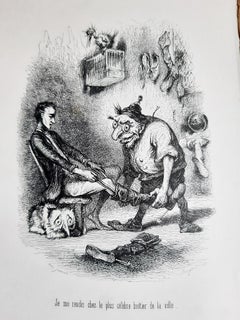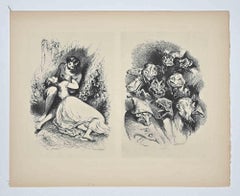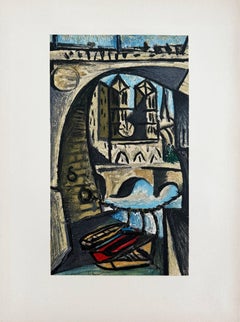Tony Johannot Figurative Prints
French, 1803-1852
Tony Johannot was a French engraver, illustrator and painter. Johannot learned engraving from his brothers and helped Alfred produce illustrations of books by James Fenimore Cooper and Walter Scott. Johannot came to prefer wood engraving but resumed etching in 1845. His historical paintings were exhibited at the Paris Salon for the first time in 1831. Johannot became an illustrator much prized for his elegance, his diversity and the lively character of his drawings.
to
2
Overall Width
to
Overall Height
to
2
11
847
382
381
308
2
1
1
1
1
1
1
2
1
1
Artist: Tony Johannot
Voyage où il Vous Plaira - Rare Book Illustrated by Tony Johannot - 1843
By Tony Johannot
Located in Roma, IT
Voyage où il vous plaira is an original modern rare book written by P.J. Stahl and Alfred De Musset and illustrated by Tony Johannot (9 November 1803 – 4 August 1852) in 1843.
Original First Edition.
Published by Hetzel, Paris.
Format: large 8°.
The book includes 170 pages with hundreds of illustrations (63 of them are full page woodcuts).
Mint conditions.
Tony Johannot (9 November 1803 – 4 August 1852). Johannot was a French engraver, illustrator and painter. His historical paintings were exhibited at the Paris Salon for the first time in 1831. He became an illustrator much prized for his elegance, his diversity, and the lively character of his drawings, which were converted to engravings either by himself or by such artists as Jacques Adrien Lavieille, Émile Montigneul, and Alfred Revel. He was praised by Théophile Gautier.
Category
1840s Modern Tony Johannot Figurative Prints
Materials
Paper, Woodcut
Brugnot et Tamisier - Original Woodcut by Tony Johannot - 19th Century
By Tony Johannot
Located in Roma, IT
Brugnot et Tamisier is an original woodcut print realized after Tony Johannot (1803–1852) in the 19th century.
The original work is contained in a white passepartout (35x51 cm).
Good condition.
Hand-signed.
Antoine Johannot, known commonly as Tony Johannot (1803–1852), was a French engraver, illustrator and painter. Tony learned engraving from his brothers and helped Alfred produce illustrations of books by James Fenimore Cooper...
Category
19th Century Modern Tony Johannot Figurative Prints
Materials
Woodcut
Related Items
Notre-Dame
By Pablo Picasso
Located in OPOLE, PL
Pablo Picasso (1881-1973) - Notre-Dame
Lithograph from 1957.
The edition no. 211/275.
With Arches watermark.
Dimensions of work: 44.5 x 33.5 cm.
Publisher: Fernand Mourlot Édite...
Category
1950s Modern Tony Johannot Figurative Prints
Materials
Lithograph
Wedding Party
Located in Buffalo, NY
An original mid century modern woodblock print.
This work is hand signed illegibly and titled "Wedding Party".
Category
1960s Modern Tony Johannot Figurative Prints
Materials
Paper, Woodcut
Peace
By Anton Refregier
Located in Fairlawn, OH
Peace
Woodcut printed in orange red ink on japanese paper
Signed and titled in pencil lower right (see photo)
Titled lower left (see photo)
Created along with an illustrated book project Song of Peace, 1950-1959.
Condition: Excellent
Image: 10 1/2 x 4 7/8"
Sheet: 16 1/8 x 7";
Anton Refregier (March 20, 1905 – October 10, 1979) was a painter and muralist active in Works Progress Administration Federal Art Project commissions, and in teaching art. He was a Russian immigrant to the United States.
Among his best-known works is his mural series The History of San Francisco, located in the Rincon Center in downtown San Francisco, California. It depicts the city's history across twenty seven panels that he painted from 1940 to 1948.
Life and early career
Refregier was born in Moscow and emigrated to the United States in 1920. After working various odd jobs in New York City, he earned a scholarship to the Rhode Island School of Design in 1921. After finishing school, Refregier moved back to New York in 1925. To earn a living, Refregier worked for interior decorators, creating replicas of François Boucher and Jean-Honoré Fragonard paintings...
Category
1950s American Modern Tony Johannot Figurative Prints
Materials
Woodcut
No Footprints Show, Where the Flowers Grow Deep
By Shiko Munakata
Located in Fairlawn, OH
No Footprints Show, Where the Flowers Grow Deep
Woodcut, 1961
Unsigned (as isssued)
From: The "Way" of the Woodcut, three woodcuts, 1961
Publisher: Pratt Adlib Press, Brooklyn, New Y...
Category
1960s Modern Tony Johannot Figurative Prints
Materials
Woodcut
Mother And Child
By Romare Bearden
Located in New York, NY
Color screenprint on paper. Signed by the artist in pencil, lower right. Numbered 71/200 in pencil, lower left.
Catalogue raisonne refernece: Gelburd/Rosenberg 59.
Framed d...
Category
1970s Modern Tony Johannot Figurative Prints
Materials
Screen, Color
Werner Drewes, Winter, 1933, modernist woodcut
By Werner Drewes
Located in New York, NY
A modernist fantasy winter scene created by Werner Drewes, this print brings key aspects of the period together. His cubist-inspired woodcut technique is utilized here to bring the s...
Category
1930s American Modern Tony Johannot Figurative Prints
Materials
Woodcut
Les Amoureux dans le ciel à St-Paul
By Marc Chagall
Located in New York, NY
Etching on paper, 1968. Signed by the artist in pencil, lower right. Numbered 9/50 in pencil, lower left.
Catalogue raisonne reference: Cramer 36
Category
1960s Modern Tony Johannot Figurative Prints
Materials
Etching
Coloquio
By Francisco Zúñiga
Located in New York, NY
Color lithograph with full margins. Artist's proof inscribed "E II", from "Estado II" edition of 30, aside from the edition of 63. Signed, dated and numbered XXIV/XXX in pencil, lowe...
Category
1970s Modern Tony Johannot Figurative Prints
Materials
Lithograph
Modern American Industrial Landscape
Located in Buffalo, NY
An original woodblock print dated 1965, titled "Our Town" but signed illegibly.
Category
1960s American Modern Tony Johannot Figurative Prints
Materials
Paper, Woodcut
By Night On My Bed
Located in New York, NY
Woodcut. Signed by the artist and dated in pencil, lower right. Titled in pencil, lower left, and numbered "28" in pencil, lower center.
This woodcut was made by Esherick to ill...
Category
1920s American Modern Tony Johannot Figurative Prints
Materials
Woodcut
Harvest #2
By Walter Williams
Located in New York, NY
Color woodcut. Signed by the artist in pencil, lower right. Titled "Harvest 2" in pencil, lower center. Numbered "2nd 5/12 Special Edition" in pencil, lower left.
Framed dimensi...
Category
1960s Modern Tony Johannot Figurative Prints
Materials
Woodcut, Color
Return of the Jedi 1983 Original Vintage Poster
Located in London, GB
Return of the Jedi 1983 Original Vintage Poster
measures 27×41" inches / 68 x 104 cm
unfolded
rolled
excellent condition
Return of the Jedi (also known as Star Wars: Episode VI ...
Category
1980s Modern Tony Johannot Figurative Prints
Materials
Paper, C Print
Tony Johannot figurative prints for sale on 1stDibs.
Find a wide variety of authentic Tony Johannot figurative prints available for sale on 1stDibs. You can also browse by medium to find art by Tony Johannot in woodcut print, paper and more. Much of the original work by this artist or collective was created during the 19th century and is mostly associated with the modern style. Not every interior allows for large Tony Johannot figurative prints, so small editions measuring 8 inches across are available. Customers who are interested in this artist might also find the work of J. J. Grandville, Denis Auguste Marie Raffet, and Paul Gavarni (Guillaume Sulpice Chevalier). Tony Johannot figurative prints prices can differ depending upon medium, time period and other attributes. On 1stDibs, the price for these items starts at $275 and tops out at $1,114, while the average work can sell for $695.
Artists Similar to Tony Johannot
Paul Gavarni (Guillaume Sulpice Chevalier)


